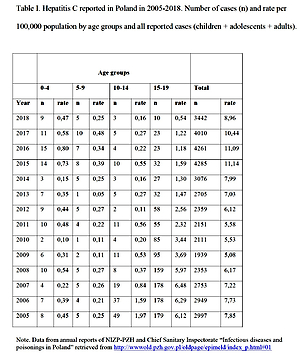Current issue
Archive
Manuscripts accepted
About the Journal
Editorial office
Editorial board
Section Editors
Abstracting and indexing
Subscription
Contact
Ethical standards and procedures
Most read articles
Instructions for authors
Article Processing Charge (APC)
Regulations of paying article processing charge (APC)
HEPATOLOGY / STATE OF THE ART PAPER
The micro-elimination approach - a new way of tackling hepatitis C in paediatric population
1
Department of Children’s Infectious Diseases, Medical University of Warsaw, Poland
2
Warsaw's Hospital for Infectious Diseases, Poland
Submission date: 2020-12-27
Final revision date: 2021-05-07
Acceptance date: 2021-05-28
Online publication date: 2021-06-04
Corresponding author
Magdalena Dominika Pluta
Department of Children’s Infectious Diseases, Medical University of Warsaw, Wolska 37 Street, 01-201, Warsaw, Poland
Department of Children’s Infectious Diseases, Medical University of Warsaw, Wolska 37 Street, 01-201, Warsaw, Poland
KEYWORDS
TOPICS
ABSTRACT
Recent advances in antiviral drug development towards the hepatitis C virus(HCV) have revolutionized the therapy and paved the way towards the elimination of chronic hepatitis C (CHC). Difficulties in achieving time-bound elimination targets of the World Health Organization’s Global Strategy on viral hepatitis might be overcome through a novel micro-elimination approach. A new, emerging strategy focuses elimination efforts on high-risk and ignored populations, and therefore allows for quick, efficient targeting of treatment and prevention services. So far, gaps in antenatal and/or paediatric care, and a lack of reimbursement and approval of direct-acting antivirals (DAA) in the paediatric population have been a barrier to accessing treatment, leading to marginalization of children and adolescents. Recently approved DAAs for use in children aged ≥ 3 years seem to be the cornerstone of HCV elimination by reducing the risk of future horizontal and vertical transmission, firstly on a national, and ultimately on a global level.
Share
RELATED ARTICLE
We process personal data collected when visiting the website. The function of obtaining information about users and their behavior is carried out by voluntarily entered information in forms and saving cookies in end devices. Data, including cookies, are used to provide services, improve the user experience and to analyze the traffic in accordance with the Privacy policy. Data are also collected and processed by Google Analytics tool (more).
You can change cookies settings in your browser. Restricted use of cookies in the browser configuration may affect some functionalities of the website.
You can change cookies settings in your browser. Restricted use of cookies in the browser configuration may affect some functionalities of the website.



